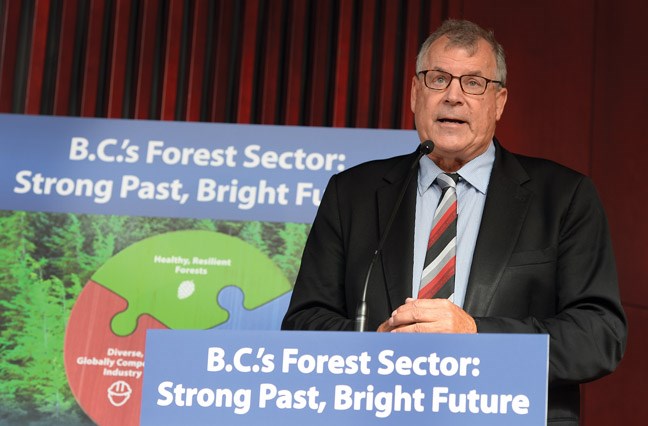The provincial government released a strategy Wednesday to ease the impact of a looming fall-down in the annual allowable cut as the aftermath of the mountain pine beetle epidemic takes hold in B.C.'s forests.
Entitled "Strong Past, Bright Future," it was unveiled at an event at the Wood Innovation and Design Centre, and contains 49 actions aimed at three inter-related goals: healthy, resilient forests; diverse, globally competitive industry; and stable communities and First Nations.
A forecast shows the AAC for the Prince George Timber Supply Area diving from the current 12.5 million cubic metres available since 2011 to an expected 6.2 million cubic metres in 2020. Before the mountain pine beetle epidemic, it sat at 9.2 million. B.C.'s chief forester is expected to make a decision on the AAC this fall.
"It will be decades before the province's timber supply returns to what it was before the mountain pine beetle infestation," Forests, Lands and Natural Resource Operations Minister Steve Thomson said as about 50 people - many from the local forest industry - looked on.
"It's a reality that will present some significant challenges for forestry in the coming years. There's not going to be as much timber available and the chief forester will be continuing to make adjustments to the annual allowable cut.
"But the key to meeting these challenges is to go through this process, ensuring that our industry is competitive as possible."
Highlights from the strategy for Thomson included:
- promoting innovation in construction techniques using wood and "biomaterials" such as cellulose from the pulp and paper industry;
- opening up new markets overseas, notably India;
- continuing to market B.C.'s "green advantage" as a producer of new wood-based products and building systems.
"These are challenging times for the forest industry," Thomson said. "We're committed to meeting these challenges and to have a comprehensive agenda to guide us now and into the future."
Prince George-Valemount MLA Shirley Bond said the budget for the province's Forests for Tomorrow reforestation program for land hit by the beetle and wildfire, now stands at almost $75 million, a $10-million increase.
"This sets the stage for additional surveys and site preparation to plant $28 million seedlings annually by 2019-2020," she said and added it dovetails with the province's climate action plan. Growing trees absorb carbon, a key component of greenhouse gas.
In an interview after the announcement, Thomson said the aim is to start by replanting 20,000 hectares and increase that by 20,000 each year to reach a goal of 300,000 replanted in five years.
The newly-created Forest Enhancement Society is getting $85 million to reduce wildfire risk around communities and rehabilitate forests damaged by the beetle, and $75 million over three years will go to a rural dividend program to help small communities through economic transition, Bond said.
"B.C.'s economy has diversified in recent years and forests may not be the predominant sector it once was but it's still absolutely a critical component of our province's economic backbone," Bond said.
NDP Opposition Forests, Lands and Natural Resource Operations critic Harry Bains said the strategy consists of "stuff that should've gone on for the last 15 years."
"I think it's more electioneering than a real forestry plan because if they wanted to do it, they should've done it 10 years ago, they haven't done it and now they're talking about even further down the road," Bains added.
Much of the plan amounts to reannouncements of initiatives.
"It's more of what (Premier) Christy Clark normally does, lofty announcements and hardly anything to back it up and reannounce it three or four times again," Bains said.
Among the goals in an accompanying plan for the value-added sector is to exempt manufacturers in that sector from the new Canada-U.S. softwood lumber agreement because they buy their material on the open market.
Bains accused the governing B.C. Liberals of raising the proposal at the last minute. If an agreement is not in place by Oct. 12, U.S. tariffs on exports from B.C. will kick in. "They need to show some leadership, they haven't done that," Bains said.
When he was in Prince George last week, NDP leader John Horgan accused Clark of "being silent" on the negotiations.
Thomson differed with the comment on Wednesday. "We have been working very, very diligently and actively on the file," he said.



